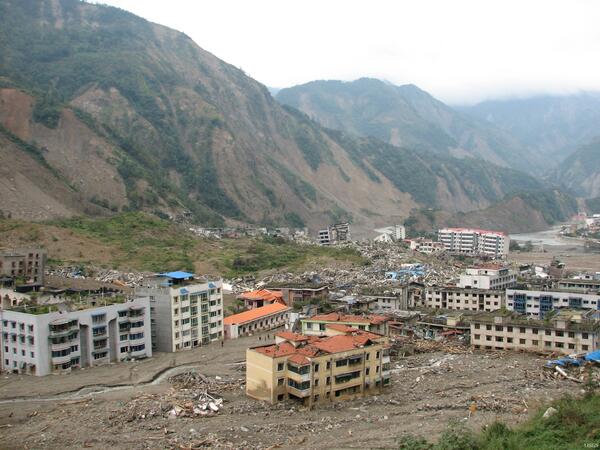NetQuakes strong-motion instruments enable seismologists to collect extensive data in urban areas where installing traditional seismographs is not practical. This instrument (in blue, to the right of the upended chairs) takes up very little space in a San Francisco Bay Area resident's garage.
Images
NetQuakes strong-motion instruments enable seismologists to collect extensive data in urban areas where installing traditional seismographs is not practical. This instrument (in blue, to the right of the upended chairs) takes up very little space in a San Francisco Bay Area resident's garage.
Children participating in an earthquake drill on April 23, 2009, at the British School in Tokyo, Showa Campus. The drill is based on the Japanese Earthquake Early Warning System.
Children participating in an earthquake drill on April 23, 2009, at the British School in Tokyo, Showa Campus. The drill is based on the Japanese Earthquake Early Warning System.
Children participating in an earthquake drill on April 23, 2009, at the British School in Tokyo, Showa Campus. The drill is based on the Japanese Earthquake Early Warning System.
Children participating in an earthquake drill on April 23, 2009, at the British School in Tokyo, Showa Campus. The drill is based on the Japanese Earthquake Early Warning System.

Secretary of the Interior Ken Salazar announced the U.S. Geological Survey will fund $29.4 million in earthquake network upgrades nationwide through the American Recovery and Reinvestment Act of 2009.
Secretary of the Interior Ken Salazar announced the U.S. Geological Survey will fund $29.4 million in earthquake network upgrades nationwide through the American Recovery and Reinvestment Act of 2009.

A filtered vertical laser image, taken using a technique called light detection and ranging (LIDAR), of part of the Hayward Fault (red lines) in the City of Berkeley. The fault passes through the University of California Berkeley football stadium (left), and past earthquake movements have significantly offset Hamilton Gulch (center).
A filtered vertical laser image, taken using a technique called light detection and ranging (LIDAR), of part of the Hayward Fault (red lines) in the City of Berkeley. The fault passes through the University of California Berkeley football stadium (left), and past earthquake movements have significantly offset Hamilton Gulch (center).

ShakeMap showing the inferred intensity of ground shaking in the 1868 earthquake (measured as MMI, or Modified Mercalli Intensity), compared to a ShakeMap for the 1989 magnitude 6.9 Loma Prieta earthquake.
ShakeMap showing the inferred intensity of ground shaking in the 1868 earthquake (measured as MMI, or Modified Mercalli Intensity), compared to a ShakeMap for the 1989 magnitude 6.9 Loma Prieta earthquake.

The May 12, 2008, Great Sichuan Earthquake, also called the Wenchuan Earthquake, occurred at 14:28 local time, in Sichuan Province, China. The earthquake magnitudes were Mw = 7.9 (USGS), Ms = 8.0 (Chinese Earthquake Administration). The epicenter was 80 km west-northwest of Chengdu, the capital city of Sichuan province.
The May 12, 2008, Great Sichuan Earthquake, also called the Wenchuan Earthquake, occurred at 14:28 local time, in Sichuan Province, China. The earthquake magnitudes were Mw = 7.9 (USGS), Ms = 8.0 (Chinese Earthquake Administration). The epicenter was 80 km west-northwest of Chengdu, the capital city of Sichuan province.
The citizens of Jianxin have already started reconstruction after the 12 May 2008 earthquake.
The citizens of Jianxin have already started reconstruction after the 12 May 2008 earthquake.
An elderly Jianxin woman in her emergency shelter.
An elderly Jianxin woman in her emergency shelter.
A Jianxin shrine damaged in the 12 May 2008 earthquake.
A Jianxin shrine damaged in the 12 May 2008 earthquake.
Emergency tents have been set up along a roadway that connects Jiangyou and Jianxin.
Emergency tents have been set up along a roadway that connects Jiangyou and Jianxin.
The emergency tents given to the Chinese after the 12 May 2008 earthquake serve as living spaces for those who cannot stay in their homes.
The emergency tents given to the Chinese after the 12 May 2008 earthquake serve as living spaces for those who cannot stay in their homes.
Citizens of Jiangyou set up their emergency tents inside a concrete structure after the 12 May 2008 earthquake.
Citizens of Jiangyou set up their emergency tents inside a concrete structure after the 12 May 2008 earthquake.
The 12 May 2008 earthquake caused structural damage to these buildings in Zhuyuan.
The 12 May 2008 earthquake caused structural damage to these buildings in Zhuyuan.
The 12 May 2008 earthquake reduced this building to a pile of rubble in Zhuyuan.
The 12 May 2008 earthquake reduced this building to a pile of rubble in Zhuyuan.
Some citizens of Malu had to construct their own tents after the 12 May 2008 earthquake.
Some citizens of Malu had to construct their own tents after the 12 May 2008 earthquake.
Associated with the 12 May 2008 earthquake, rock and landslides have presented a major problem to the Chinese.
Associated with the 12 May 2008 earthquake, rock and landslides have presented a major problem to the Chinese.
Japan helped the Chinese in the wake of the 12 May 2008 earthquake.
Japan helped the Chinese in the wake of the 12 May 2008 earthquake.
A sea of tents with damaged buildings in the background in Malu.
A sea of tents with damaged buildings in the background in Malu.
Emergency tents off the side of a road in Zhuyuan were erected after the 12 May 2008 earthquake.
Emergency tents off the side of a road in Zhuyuan were erected after the 12 May 2008 earthquake.
The 12 May 2008 earthquake in China was strong enough to destroy this building in Guanzhang.
The 12 May 2008 earthquake in China was strong enough to destroy this building in Guanzhang.


















